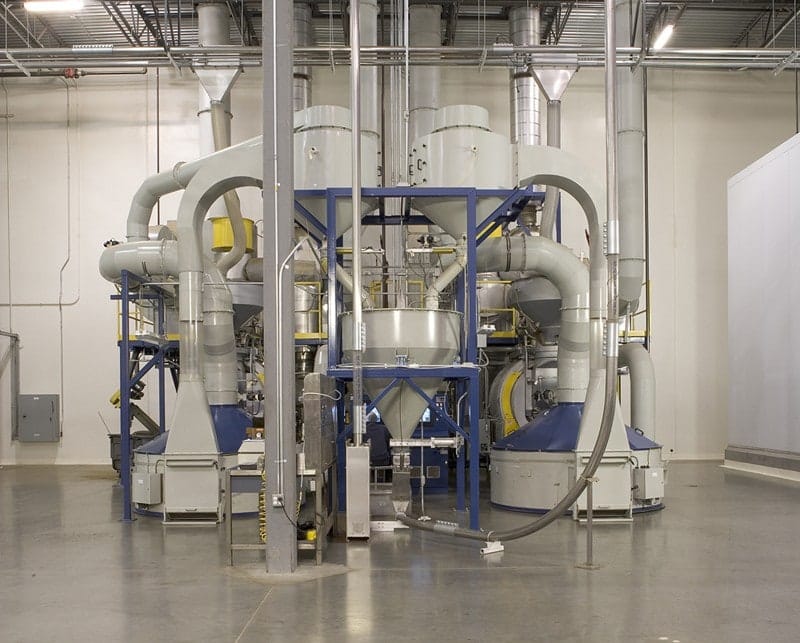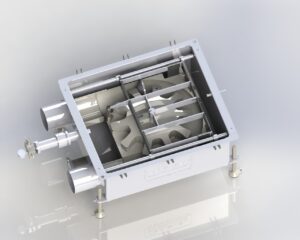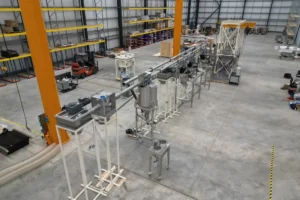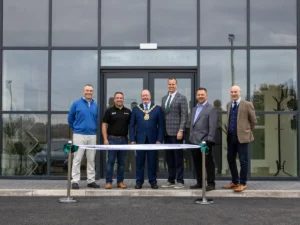From bulk material handling equipment to a belt conveyor system, producing quality coffee blends requires a specialized approach. Tubular drag cable conveyors for green coffee beans are crucial for smooth blends, as numerous companies can attest to. Let’s see how the system operates and how it has positively impacted the production of Apffels Fine Coffee.
Tubular Drag Cable Conveyors for Green Coffee Beans Reduce Operating Costs and Improve Production Efficiency
Apffels Fine Coffees, Santa Fe Springs, California, produces a wide range of custom blended regular and flavored whole bean and ground coffees and other coffee ingredients for food stores, private labelers, and food-service establishments. The company imports hand-picked green coffee beans and custom-blends and roasts them to make whole-bean and ground coffee products that are packaged in 1-ounce to 5-pound valve bags for distribution.
In early 2004, the company worked with an engineering firm to design and build a new advanced computer-aided roasting facility for small-batch and high-volume production runs. When planning the facility, the company needed to install a conveying system (including a conveyor belt for the warehouse) that would efficiently and gently move the coffee beans and ground coffee through the production process without diminishing product quality.

The Journey to Finding Better Conveyors
In the past, the company used bucket elevators, augers, and pneumatic conveyor systems to move the beans and ground coffee through the blending, roasting, grinding, flavoring, and packaging processes. However, these conveyors were maintenance and labor-intensive and required excessive production downtime to clean between product runs to prevent cross-contamination.
“This kept our operation costs high and decreased our production efficiency,” says Darryl Blunk, Apffels president. “The conveyors also broke the roasted coffee beans and declassified the coffee grounds because of the way they worked. This was a problem because we want unbroken beans and a consistent grind distribution at the end when we package the final product.”
The Decision to Use Tubular Drag Cable Conveyors
When the company decided to build the new facility, it worked closely with Nohbell Corp. in Bellevue, Washington, an engineering firm that specializes in designing, developing, and implementing supply-chain operations for coffee, wine, and food processors. During the planning stage, the engineering firm recommended that the company use enclosed tubular drag cable conveyors to move the beans and ground coffee through the production process.
Based on the engineering firm’s experience in the coffee industry, these slow-running, dust-free conveyors would carefully convey the friable roasted beans and ground coffee without breaking the beans or stratifying the grounds. And because of how the conveyors move material through the enclosed tubes, they would also reduce maintenance and cleaning requirements and improve production efficiency and product quality.
The company sent samples to a recommended conveyor supplier for testing – our company, Cablevey Conveyors. Our specialties include a tubular conveyor system and an industrial conveyor belt for food processing, agriculture, wood, and other bulk solids industries. The tests proved successful, and the coffee roasters company’s engineers worked with our engineering team to custom-design eight conveying systems for the new facility.

Tubular Drag Cable Conveyors Come With Numerous Benefits
Cablevey’s technicians installed eight Model 4000 Series tubular drag cable conveyors, some of which have multiple discharges, in the company’s new roasting facility. Each conveyor consists of two 4-inch-diameter enclosed tube sections (an infeed and a return tube) with a turnaround section at one end and a variable-speed 5-horsepower drive-and-sprocket assembly at the other.
The Design of a Tubular Drag Cable Conveyor
The turnaround section connects the infeed and return tubes at the infeed end and includes an automatic cable-tensioning device. The drive and sprocket assembly connect the tubes at the discharge end, forming a continuous circuit. If necessary, a strategically placed mechanical corner in the conveying circuit redirects material at a horizontal or vertical right angle. The conveyor is constructed of stainless steel, making it suitable for food-grade applications.
A continuous flexible stainless steel cable is installed inside the enclosed tubes, and solid, food-grade, ultra-high-molecular-weight polyethylene (UHMW-PE) circular discs are mounted on the cable at regular intervals. The discs are shaped to ease material movement and reduce degradation.
Since the discs are nearly the same diameter as the tubes, their narrow clearance with the tube walls ensures that the material stays between them during conveying and minimizes residue on the tube walls. To minimize downtime between product runs, a food-grade clean-out disc mounted on the cable keeps the tubes clean, and a continuously operating air knife at the outlets blows air across the discs when they pass to dislodge any material from them.
Automated Conveying System That Allows Remote Control
The production process equipment and conveying systems are fully automated and integrated with a central controller, allowing remote control and monitoring of the entire process from one location. Using the controller interface, an operator creates a recipe for a custom-blended coffee product and pushes the start button. The controller then automatically opens and closes the necessary valves, and the conveying system discharges to move the beans and ground coffee through the production process from the bag-break station to the packager.
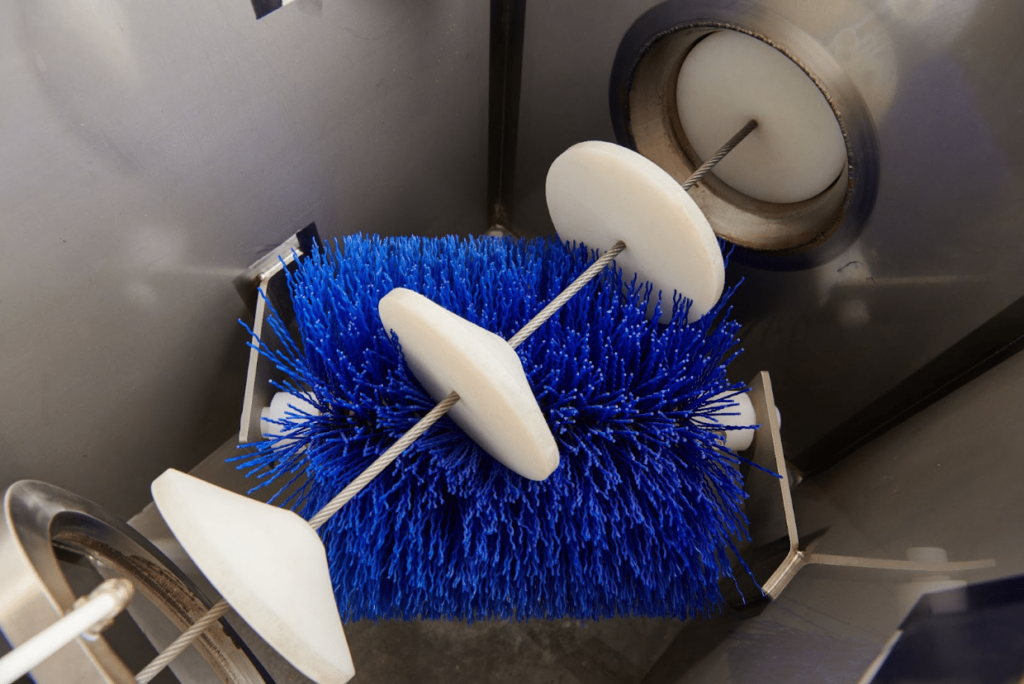
How to Make a Custom-Blended Coffee Product
To make a custom-blended coffee product, an operator empties the specified bags of green coffee beans into a bag-break station’s hopper. The beans discharge from the hopper into a small bucket elevator that moves the beans up and over to a hopper that connects with sizing and screening equipment.
The First and Second Conveying Systems
The sizing and screening equipment removes off-size beans and foreign materials such as sticks or rocks. The beans are weighed and then discharged into the first tubular drag cable conveying system, which moves them to one of six silos. To blend the beans, the controller activates the appropriate silo discharge valves to gravity-discharge the correct combination of beans into a large hopper. This discharges to the second conveying system, which then moves the blend to one of two roasters for roasting via the system’s two discharges.
The Third and Fourth Conveying Systems
The roasted beans discharge into the third conveying system, which moves them to one of 12 holding silos. The controller activates the appropriate holding silo discharge valves to gravity-discharge the beans into the fourth conveying system, which can move the beans to one of three locations via the system’s four discharges: the flavoring room, one of two grinders, or the packaging room conveying system.
The Fifth and Sixth Conveying Systems
If the beans are directed to a grinder, the ground coffee discharges into the fifth conveying system, which can move it to either one of four degassing silos or to the packaging room conveying system via the system’s two discharges. The sixth conveying system moves the ground coffee from the degassing silos to either the flavoring room or the packaging room conveying system via the system’s two discharges.
The Seventh and Eighth Conveying Systems
The packaging room conveying system is the seventh system, and it moves both regular and flavored coffee beans and ground coffee to one of four packaging stations via the system’s four discharges. The company uses the eighth conveying system to put rework back into the production process. By way of this system’s two discharges, the material can be moved to either the third conveying system that connects to the holding silos or the fourth conveying system that connects with the grinders, flavoring room, and packaging room conveying system.

Cablevey’s Tubular Conveyors Guarantee Efficiency and Safety
According to Guillermo Contreras, Apffels’ production manager, the company operates the conveying systems at 85 percent of their maximum 100-foot-per-minute rate and can move 3,000 pounds of ground coffee from a grinder to the degassing silos in about 45 minutes. Overall, the eight conveying systems have a total of 1,970 feet of tubing. To ensure safety during operation, if a cable is tensioned too quickly or breaks or a turnaround-section cover is opened, the system automatically shuts down and sounds an alarm to alert the operators.
Improvements in the Production Process
Since installing the tubular conveyors in the new roasting facility, the clean-out time between product runs and the maintenance and labor requirements have significantly decreased. “The clean-out discs inside the tubes take out just about everything, leaving little to no residue on the tube walls, so it only takes about fifteen to twenty minutes between products,” says Contreras.
“We’ve been using them for more than seven years, and I haven’t had to do much to them other than maintain the gearboxes, turnarounds, and drives. And if a cable or disc ever breaks, we just have to splice in a new cable section or mount a new disc on the cable, and we’re running again. It only takes about an hour, depending on where the break occurs, and I keep plenty of spare parts onsite. We once had to replace a full cable, and the system was only down for about half a day, which is much less time than it would take to fix the bucket elevators.”
The conveying systems have drastically improved the company’s production efficiency and product quality. “The conveyors maintain the grind consistency as they move the ground coffee through the process to packaging,” says Blunk. “We’ve also seen a significant decrease in bean breakage because the conveyors move the beans so gently. They’ve really helped us improve and maintain the quality of our whole-bean and ground coffee products.”
Cablevey Will Continue to Be a Reliable Partner in Future Endeavors
According to Blunk, if the company expands the current production process or adds a new one, Cablevey will be the first one he will call for conveyors. “Their conveying systems have enabled us to consistently produce top-quality products and easily maintain a dust-free, sanitary operation for more than seven years now, which is critical from a food-safety standpoint,” he says.
“They’ve been a good partner and have always been responsive. We definitely challenged them with this installation, but there were things we discovered during the installation process that helped them improve and enhance their conveyors, so I think it’s been a win-win situation for both of us.”
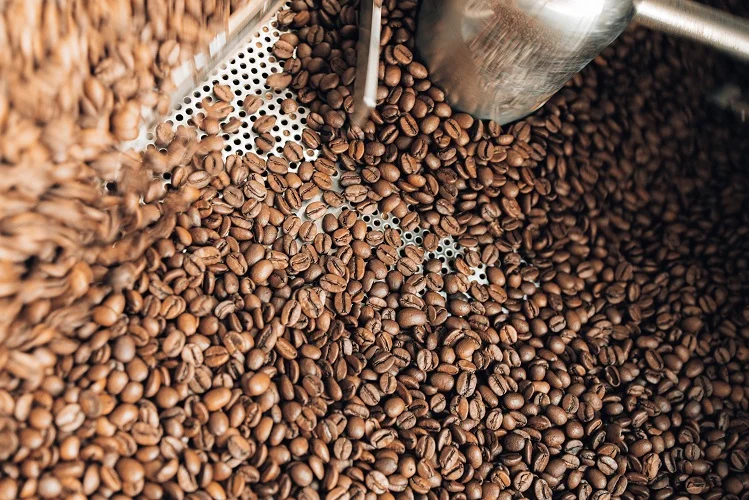
If You’re Looking for the Best Tubular Drag Cable Conveyors for Green Coffee Beans, Reach Out to Cablevey
Whether you need a good old conveyor belt system for food processing or a state-of-the-art tubular drag cable conveyor, Cablevey is the go-to company that will supply you with the best machines for your business. With our expertly designed conveyor systems by your side, nothing can go wrong – a safe and efficient production process is promised. Contact us – we will help you improve productivity and take your business to the next level.
FAQ
What Are Tubular Drag Cable Conveyors, and Why Are They Important for Coffee Bean Processing?
Tubular drag cable conveyors are crucial for producing quality coffee blends. They gently and efficiently move green coffee beans through various processing stages without causing damage. These conveyors are critical in ensuring consistent grind distribution and minimal bean breakage, resulting in higher product quality.
How Do Tubular Drag Cable Conveyors Compare to Traditional Methods Like Bucket Elevators and Pneumatic Conveyor Systems?
Traditional methods like bucket elevators were labor and maintenance-intensive, causing increased operational costs and reduced production efficiency. Moreover, they led to bean breakage and inconsistency in ground coffee. In contrast, tubular drag cable conveyors are dust-free, reduce maintenance and cleaning needs, and maintain product quality by moving beans and grounds gently.
Why Is It Best to Switch to Tubular Drag Cable Conveyors?
The switch should be made to improve production efficiency and maintain product quality. Previous systems were labor-intensive and required extensive downtime for cleaning. By adopting the tubular conveyor system, you can achieve a smoother, more efficient process with reduced bean breakage and consistent grind distribution.
How Does the Design of a Tubular Drag Cable Conveyor Contribute to Its Effectiveness?
The conveyor consists of two enclosed tube sections with a continuous flexible stainless steel cable inside. Discs, made from ultrahigh-molecular-weight polyethylene, are mounted on the cable, easing material movement and reducing degradation. Due to the design, the material stays between the discs during conveying, ensuring minimal residue and maximizing cleanliness.
How Is the Production Process Automated With These Conveyors?
The entire production process, including the conveying systems, is integrated with a central controller. This allows remote control and monitoring of the entire process. An operator can set a recipe for a custom-blended coffee product, and the controller automates the necessary valves and conveying system discharges.
What Improvements Can Be Observed After Installing Tubular Drag Cable Conveyors?
There will be a significant reduction in clean-out time between product runs, and maintenance requirements will decrease. There’s a noted decrease in bean breakage, ensuring higher product quality. Moreover, the conveyors have streamlined the production process, resulting in increased efficiency and better-quality products.
Why Choose Cablevey for Tubular Drag Cable Conveyors?
Cablevey Conveyors offers state-of-the-art tubular drag cable conveyors tailored for green coffee beans and other applications. With the company’s expertise, businesses can achieve a safe, efficient production process. Cablevey has consistently provided top-quality, dust-free, sanitary conveyor solutions, proving itself a reliable partner for food processing endeavors.

